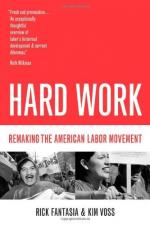|
This section contains 388 words (approx. 2 pages at 300 words per page) |
Nineteenth Century Organized Labor in the U.S.
During this period in the United States history, a new kind of immigrant was coming to the states. Previously almost all the immigrants had been from Western Europe. They assimilated well and adapted to American ways of life. However, immigrants started coming from Eastern and Southern Europe during this time. Also, Chinese immigrants came to the west. These immigrants were generally poorer and less educated than the immigrants from Western Europe. Their cultures were farther from that of America and they did not want to assimilate. These immigrants were a great source of labor for the factories. They would work for next to nothing. Because factory owners could hire these immigrants for so cheap, they didn't need to worry about paying higher wages to the Americans that had been there. This is an area where organized labor failed terribly. Trying to strike only worsened their case. Once on strike, factory owners were the ones who gained rather than the strikers, because they just filled their factories with cheap immigrant labor.
The Sherman Antitrust Act was made into law in 1890. Its purpose was to prevent monopolies by stopping anyone from restricting the flow of trade. However, during its early years it was used quite oppositely in the courts. At first, the Sherman Antitrust Act protected big business and shot down organized labor. In Homestead, Pennsylvania in 1892, steel workers experienced a lockout.
In 1894 3,000 workers from the Pullman Company went on strike. Discontented workers joined the ARU but in the end it did no good. Eventually President Cleveland claimed that the strike was interfering with the delivery of US mail and sent in 12,000 troops to brake up the strike and send the workers back to their jobs.
|
This section contains 388 words (approx. 2 pages at 300 words per page) |


